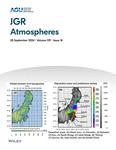Evaluation of Eddy Covariance Footprint Models Through the Artificial Line Source Emission of Methane
Liu, Shuo , Liu, Gang , Zhang, Mi , Sun, Yufang , Fang, Shuangxi , Zhen, Xiaojie , Feng, Zhaozhong
2022-08-27 null null 127(卷), null(期), (null页)
This paper evaluates the performance of footprint models through a line source (LS) system releasing methane (CH4) measured by an eddy covariance (EC) system in a rice-wheat rotation agro-ecosystem. Two footprint models namely Kormann and Meixner (KM) and Flux Footprint Prediction (FFP), are used. The line source width (LW) was introduced, which could highly impact the model estimation, leading to an error of similar to 500% for the FFP and similar to 200% for the KM. The surface roughness length (z(0)) also affects the FFP estimation, which is much weaker than the effect of LW with a 15% error. An overestimation of 217.8% is observed when the LS is close to the EC system, which reduces to 12.2% when the source stays distant. The analysis of different experimental configurations illustrated that the estimated emission calculated based on footprint model improves with increasing emission height, averaging period, and emission rate. The most accurate estimations are achieved by the configurations of canopy level (CL; 5.5% overestimation), 15 min averaging period (1% underestimation), and moderate emission (ME; 1.9% underestimation), respectively. For KM, the CL-ME-30 min setup leads to the best performance, while SL (soil level)-ME-15 min is the best configuration for the FFP estimation. A multivariate regression model is proposed to provide preliminary guidance for the footprint model application. The designed LS system is valuable for validating the performance of flux measurements in the specific ecosystems (e.g., grassland, sand land, and forest) as well as other greenhouse gases (e.g., N2O and NH3).
相关推荐
- Analysis of Soil Moisture Dynamics and Its Response to Rainfall in the Mu Us Sandy Land [2022-08-27]
- Soil organic carbon and nitrogen sequestration following grazing exclusion on the Loess Plateau, China [2022-08-27]
- Exploring interactions in water-related ecosystem services nexus in Loess Plateau [2022-08-27]
- Determination of Soil Electrical Conductivity and Moisture on Different Soil Layers Using Electromagnetic Techniques in Irrigated Arid Environments in South Africa [2022-08-27]
- Multi-omics analysis reveals spatiotemporal regulation and function of heteromorphic leaves in Populus [2022-08-27]



